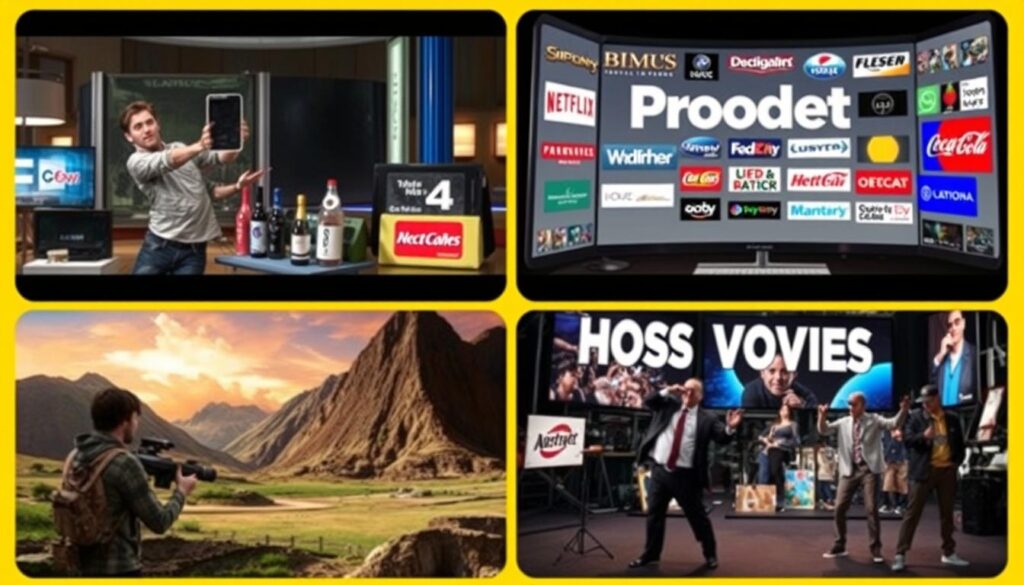
Introduction
Productionplacment Blog is a smart way to get brands into movies and TV shows. It makes brands more visible and helps people connect with them better. Brands like Coca-Cola and Nike use it to get noticed and change how people think about them.
This blog will help you understand brand integration. We’ll talk about what product placement is, how it works, and its different types. You’ll learn how to make your brand successful and get the most out of it.
Understanding Product Placement: Definition and Evolution
Productionplacment Blog is when brands show up in media like movies and TV. It started way back in 1889 with Coca-Cola in a French novel. This was one of the first times brands were in stories.
In the 1980s and 1990s, movies and TV shows started to feature brands more. This made product placement very popular.
Early Origins of Brand Integration
Productionplacment Blog began in the silent film days. Companies gave props or equipment for a chance to be seen on screen. This helped both the brands and the filmmakers.
The first paid product placement was in the 1919 film The Garage.
Modern Product Placement Techniques
Now, product placement is a smart way to get brands noticed. It fits brands into movies, TV, and more. Marketers use many ways to grab people’s attention and get them to buy things.
The Psychology Behind Product Integration
Productionplacment Blog works because it touches on what people want and feel. Brands put their products in stories that people love. This helps shape how people see brands.
Today, product placement is in social media and video games too. The lines between ads and content are getting fuzzy. Brands are finding new ways to be part of our lives.
Types of Product Placement in Media Entertainment
In the world of digital strategy, Productionplacment Blog is a big deal. It helps brands grab the audience’s attention. There are many ways to do this, from obvious to subtle.
One cool way is plot placement. Brands are hidden in the story, like Reese’s Pieces in “E.T. the Extra-Terrestrial.” Another way is script placement, where brands are mentioned in the dialogue, like in “Back to the Future.”
Screen placement is the most common. It’s when products are shown on screen but not talked about, like Ray-Bans in “Top Gun.” The digital world also brings new ways to show brands, like in video games and social media.
| Type of Product Placement | Description | Examples |
|---|---|---|
| Plot Placement | Brands are seamlessly integrated into the story and narrative | Reese’s Pieces in “E.T. the Extra-Terrestrial” |
| Script Placement | Brands are explicitly mentioned in the dialogue | Marty McFly’s request for Pepsi in “Back to the Future” |
| Screen Placement | Products are simply visible on the screen without explicit mention | Ray-Bans in “Top Gun” |
| Video Game Placement | Brands are integrated into video game environments and experiences | Adidas in “NBA 2K” series |
| Social Media Placement | Brands are featured on social media platforms as part of the content | Apple products in Instagram influencer posts |
| Retail Floor Placement | Brands are prominently displayed in retail spaces, both physical and digital | Walmart product placements in TV shows and movies |
Each way of product placement has its own chance for brands to connect with people. They use digital strategy and data to make their brand stand out.

Productionplacment Blog Best Practices for Brand Success
Successful brand storytelling and product placement need real stories that fit well with the content. It’s important to be clear about who paid for what, especially in influencer marketing. When brands fit into the story, people are more likely to accept them, like FedEx in Cast Away.
To see if product placement works, we need to watch how people see the brand, interact with it, and buy things. We also have to make sure we’re not breaking any laws. Following the rules helps make sure our product launches are good and fair.
Creating Authentic Brand Narratives
Brands should aim to tell stories that feel real and fit right into the show. For example, showing Coca-Cola cans in Stranger Things makes the brand more known without bothering the viewers. Working with the show’s team to make sure the brand message fits the story can make the product placement stand out.
Measuring Integration Effectiveness
- Watch how often the brand is seen and for how long
- See how people talk about the brand online and search for it
- Look at how many people buy things because of the brand
Legal Considerations and Compliance
Brands must get the right permissions to show their products in media. They should not use products in ways that could hurt the brand’s image. Following the rules, like being clear about who paid for what in influencer deals, is key to doing things right.

Strategic Implementation of Brand Integration
Putting brands in media takes smart planning. Businesses need to pick the right media, match their audience, and get good deals. Small companies can use new influencers or indie shows to save money and grow.
For brand integration to work, it must make the show better, not worse. Batsheva, a Shopify store, put their dresses in movies. This boosted their brand and reached more people. Zillow became known for TV show mentions, making it easy to find homes.
There are many ways to place products, like in movies, on social media, in games, or in stores. Each has its own ups and downs. Businesses must pick what’s best for them.
| Product Placement Type | Key Benefits |
|---|---|
| Film and TV Placement | Increased brand visibility, strengthened positive brand awareness |
| Social Media Placement | Engagement with target audience, real-time brand interactions |
| Video Game Placement | Immersive brand integration, reaching a tech-savvy audience |
| Retail Store Placement | In-person brand exposure, potential for impulse purchases |
Product placement has many good points, but businesses must follow the law. By planning well, they can use product placement to improve product reviews, sponsored posts, affiliate marketing, and content creation.
Maximizing ROI Through Product Placement
Unlocking digital marketing’s true power starts with data-driven analysis. For product placement, tracking key metrics is key. This helps in maximizing ROI.
Performance Metrics and Analytics
Good product placement needs measurable metrics. Marketers watch brand recall, audience reach, and more. Advanced analytics help make better decisions.
Case Studies of Successful Campaigns
Many product placement campaigns have succeeded. Hershey’s in Wings (1927) and Harley-Davidson in Avengers: Age of Ultron are examples. They show digital marketing and seo optimization can work well.
Cost-Benefit Analysis Techniques
Understanding cost-benefit analysis is crucial for ROI. Production costs and media value are important. Heineken’s $45 million for a 10-second ad in Skyfall shows the risks.
Tracking metrics, studying successes, and doing cost analyses help. This way, brands can use lead generation well. It helps marketers make smart choices and boost ROI.
Conclusion
Productionplacment Blog has grown into a smart marketing way. It lets brands reach their audience in new ways. As media changes, product placement will get even better.
It’s great for making brands known, getting people involved, and selling more. Even small shops and big companies use it. They all want to reach their goals.
With new tech and places to show ads, product placement will keep being key. Marketers must be quick, creative, and think about digital strategy, industry insights, and thought leadership. This way, brands can really connect with people and do well.
Read next – 609-923-6548: New Jersey Phone Number Details






1 thought on “Productionplacment Blog: Guide to Brand Integration”